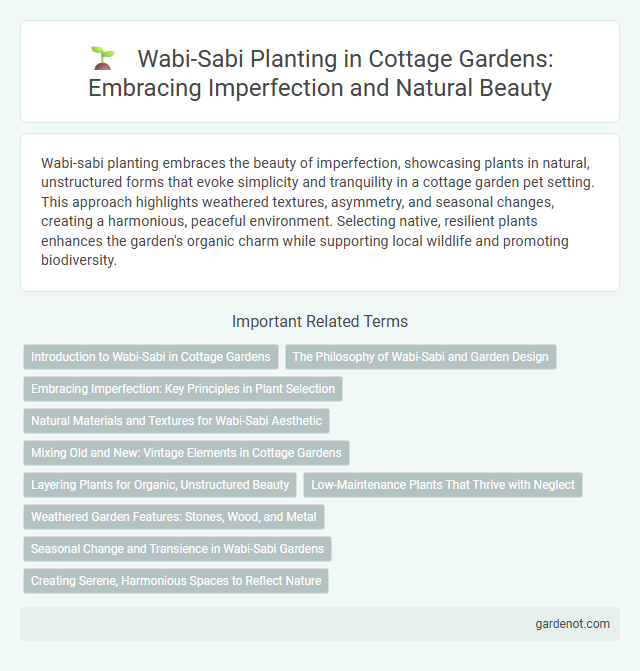Wabi-sabi planting embraces the beauty of imperfection, showcasing plants in natural, unstructured forms that evoke simplicity and tranquility in a cottage garden pet setting. This approach highlights weathered textures, asymmetry, and seasonal changes, creating a harmonious, peaceful environment. Selecting native, resilient plants enhances the garden's organic charm while supporting local wildlife and promoting biodiversity.
Introduction to Wabi-Sabi in Cottage Gardens
Wabi-sabi embraces the beauty of imperfection and transience, making it ideal for cottage garden planting styles that favor natural, unstructured growth. This Japanese aesthetic highlights weathered textures, asymmetrical arrangements, and seasonal changes, promoting plants like moss, ferns, and native wildflowers that thrive in a seemingly spontaneous yet harmonious setting. Integrating wabi-sabi principles into cottage gardens encourages sustainable, low-maintenance landscapes that celebrate the charm of aging plants and organic irregularities.
The Philosophy of Wabi-Sabi and Garden Design
Wabi-sabi planting embraces the beauty of imperfection and impermanence by incorporating asymmetrical forms, natural textures, and seasonal changes within a cottage garden. This philosophy values simplicity and authenticity, encouraging the use of native plants and organic materials to create a tranquil, unpretentious atmosphere. Garden design rooted in wabi-sabi fosters harmony with nature, highlighting the transient beauty of decay and renewal in every blooming and withering element.
Embracing Imperfection: Key Principles in Plant Selection
Wabi-sabi planting embraces imperfection by favoring plants with organic shapes, subtle colors, and natural growth patterns that evoke tranquility. Selecting flora exhibiting asymmetry, irregular textures, and seasonal changes enhances the cottage garden's authentic charm. This philosophy prioritizes resilience and harmony with nature, celebrating beauty found in impermanence and imperfection.
Natural Materials and Textures for Wabi-Sabi Aesthetic
Wabi-sabi planting in cottage gardens emphasizes embracing natural materials and textures, highlighting the beauty of imperfection and transience. Utilizing weathered wood, rough stone, and textured foliage creates an organic, serene atmosphere reflective of Wabi-sabi principles. Integrating moss, aged bark, and wildflower clusters enhances the rustic charm while maintaining harmony with the natural environment.
Mixing Old and New: Vintage Elements in Cottage Gardens
Wabi-sabi planting embraces imperfection and natural beauty by blending aged vintage elements with contemporary garden design in cottage gardens. Weathered pots, rusted tools, and reclaimed wood structures create a timeless charm that harmonizes with lush, informal plantings like lavender, foxglove, and English roses. This fusion of old and new enriches the sensory experience, highlighting simplicity and the passage of time in a uniquely authentic garden space.
Layering Plants for Organic, Unstructured Beauty
Wabi-sabi planting embraces layering plants of varying heights, textures, and colors to create an organic, unstructured beauty in cottage gardens. Utilizing a mix of native perennials, grasses, and trailing vines encourages natural growth patterns that emphasize imperfection and transience. This approach fosters a serene, harmonious landscape reflecting the philosophy's appreciation for simplicity and rustic elegance.
Low-Maintenance Plants That Thrive with Neglect
Wabi-sabi planting in cottage gardens emphasizes embracing imperfection through low-maintenance plants that thrive with neglect, such as lavender, sedum, and ornamental grasses. These resilient species require minimal watering and pruning while providing natural textures and muted colors that enhance the garden's rustic charm. Drought-tolerant and pest-resistant varieties contribute to a sustainable, easy-care landscape that reflects the serene beauty of impermanence.
Weathered Garden Features: Stones, Wood, and Metal
Weathered garden features such as worn stones, aged wood, and rusted metal enhance the Wabi-sabi aesthetic in cottage garden planting by emphasizing natural imperfection and impermanence. These materials develop character over time, blending harmoniously with lush, informal plantings like lavender, foxgloves, and climbing roses. Incorporating moss-covered stones, distressed wooden benches, and oxidized metal trellises creates a serene, timeless atmosphere that reflects the beauty of aging and organic decay.
Seasonal Change and Transience in Wabi-Sabi Gardens
Wabi-sabi planting in cottage gardens emphasizes the beauty of seasonal change and transience, showcasing plants that evolve with the passage of time. Foliage shifts, blooms fade, and natural decay highlight impermanence, encouraging appreciation of each stage in the plant's lifecycle. This approach fosters a harmonious connection between nature's cycles and garden aesthetics, celebrating the quiet elegance of imperfection.
Creating Serene, Harmonious Spaces to Reflect Nature
Wabi-sabi planting in cottage gardens emphasizes embracing imperfection and natural beauty, cultivating a serene and harmonious space that reflects the cycles of nature. Utilizing native plants, asymmetrical arrangements, and weathered textures, this approach fosters a tranquil environment rooted in simplicity and balance. Incorporating elements like moss, aged wood, and muted floral tones reinforces the aesthetic of understated elegance and organic authenticity.
Wabi-sabi planting Infographic

 gardenot.com
gardenot.com